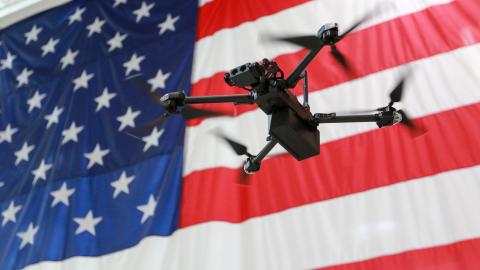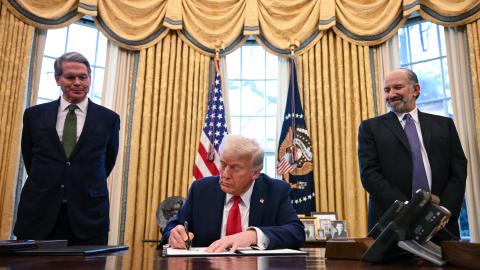Arms control failed to prevent Bashar al-Assad from using weapons of mass destruction against noncombatants, and this should serve as another hard lesson in its limitations.
Civilized nations have sought to abolish the use of chemical weapons (CWs) for nearly a century, as evidenced by the 1919 Versailles Treaty, the Geneva Protocol, and the Chemical Weapons Convention (CWC), which prohibited not only the use of chemical weapons but the production and stockpiling of them as well.
The CWC was negotiated by Presidents Ronald Reagan and George H. W. Bush, who signed the multinational treaty in 1993. The U.S. Senate ratified the treaty during the Clinton administration in 1997, but the objections to it then have proven prescient.
One such objection to it was the inability to truly verify compliance, a necessary condition for any useful agreement, lest the “agreement” serve as a restraint only to the states that are already self-restraining.
Assad’s chemical weapons attacks certainly underscore this problem.
After President Obama drew his infamous red line regarding Assad’s use of chemical weapons and then failed to persuade the Senate he had planned a prudent military response, Putin and Obama set out to strike a deal with Assad. This deal would entail Assad ratifying the CWC, something Syria had previously refused to do.
But believing that Assad would fully cooperate with inspectors and comply with the CWC was obscenely, willfully naïve. Assad clearly believed that it was in his country’s interest to possess and use chemical weapons, and he had just witnessed Obama’s unwillingness to quickly and decisively retaliate with force in response to several CW attacks. And, undoubtedly, he had noted how utterly unable the American president was to persuade senators who were inclined to support using force that he had a clear military plan in response. In other words, Assad knew threats of force were empty, and he did not fear them.
Thus, it was foolish for Obama-administration diplomats to have any measure of confidence that Assad would comply with the treaty when they had provided no credible incentive for him to do so.
Sure, he declared enough of his chemical weapons to please his patron, Putin, who was exploiting the international crisis for Russia’s gain. But it never made sense that Assad had suddenly changed his calculus and concluded it was in his interest to forgo all CWs.
This didn’t stop Obama officials from asserting that he did, and then they took credit for it.
On July 20, 2014, in a Meet the Press interview, Secretary John Kerry said of Syria, “We struck a deal where we got 100 percent of the chemical weapons out.” On August 18, 2014, President Obama said, “Today we mark an important achievement in our ongoing effort to counter the spread of weapons of mass destruction by eliminating Syria’s declared chemical-weapons stockpile.” Then, remarkably, after subsequent chemical-weapons attacks by the Assad regime, President Obama’s national-security adviser, Susan Rice, said on January 16, 2017: “We were able to find a solution that didn’t necessitate the use of force that actually removed the chemical weapons that were known from Syria, in a way that the use of force would never have accomplished. . . . We were able to get the Syrian government to voluntarily and verifiably give up its chemical weapons stockpile.”
The audacity of these statements became all the more apparent when Tony Blinken, a former deputy secretary of state and former deputy national-security adviser under Barack Obama, told the New York Times, “We always knew we had not gotten everything, that the Syrians had not been fully forthcoming in their declaration.”
Raising the obvious question: Why would so many in the administration and those in the arms-control community who advocated for the administration’s “diplomatic accomplishment” continue to be enthusiastic about a deal that was only partially followed by the other side?
Their support stems from a belief that arms control is a worthy end in itself, rather than a potential means to achieve peace or mitigate the effects of an enemy’s aggression. And it reveals an unrealistic devotion to diplomacy absent the credible threat of military force.
Dogged devotion to the ‘give peace a chance’ slogan, absent the credible threat of force, often leads to war and human suffering.
But, as history shows, this kind of dogged devotion to the “give peace a chance” slogan often leads to war and human suffering. Assad’s willingness to flout the Obama-Putin deal certainly demonstrates this in our day.
To be sure: Restraining the employment of chemical weapons is a worthy endeavor.
Chemical weapons, like nuclear weapons, are strategic in nature. Chemical warfare in the First World War led to renewed, immediate efforts to restrain their use even though they killed far fewer people than conventional arms, as is the case in the contemporary Syrian war. But there is more to war than body counts. There is a psychological side to war — a moral side to war, and chemical weapons fall outside the norms of what the most battle-hardened soldiers from civilized nations are willing to accept.
Chemical weapons cause long, agonizing deaths and, for those who survive them, a life of suffering. Chemical clouds, sometimes a ghoulish color, although often invisible, sweep silently, secretly, and indiscriminately across enemy lines . . . and across homes and schoolyards and hospitals filled with hapless noncombatants: the elderly, women, and children. Death for the victim is often preceded by seizures, foaming at mouth, and other disturbing effects that traumatize the witnessing loved ones. They are, by their very nature, weapons of terror.
The United States should not — cannot — permit their use, lest they become a normalized and conventional weapon of war. And to the Trump administration’s great credit, the United States demonstrated what we can and should do if they are used.
Just as verification is a necessary condition to a useful arms-control deal, so is enforcement. For just as President Obama said in his famous 2009 disarmament speech in Prague: “Rules must be binding. Violations must be punished. Words must mean something.”
Obama proved unwilling to enforce this sentiment, but his successor certainly seems willing.
The U.S. military strike against Syria’s Shayrat Airfield in response to Assad’s most recent chemical-weapons attack was carefully planned, limited in its military objective, and brilliantly executed. It seems to have achieved its desired tactical and strategic outcomes. According to a Pentagon spokesman, Captain Jeff Davis, the attack “severely damaged or destroyed Syrian aircraft and support infrastructure and equipment at Shayrat Airfield, reducing the Syrian government’s ability to deliver chemical weapons.” It also communicated to Syria and every other nation in possession of chemical weapons that the United States has the ability and the will to make it known that any use of chemical weapons is not worth the cost.
Assad and those like him certainly don’t care about “international norms” let alone notions of what civilized nations deem inherently immoral. But they do care that the world not see them as weak, and they care about their own survival. They do care if we embarrass them by showcasing their weakness, and if we threaten their survival by using force. And the more credible the U.S. threat of force is, the less we will have to use it.

















